A bonsai is said to lean forward when its apex lies in front of the base of the trunk. For example:

Pine viewed from the left side – the apex is over the front edge of the pot.
A forward lean is common to many, many bonsai in Japan. I don’t know when or why this approach to styling caught on (or whether or not it’s coincidence that bonsai silhouettes so often resemble kabuto – whoever first made this connection was right on). Boon often notes that when one stands in front of a large tree and looks straight up, the tree appears to lean towards us, and so it is with bonsai.
Were I more prolix – and less pragmatic – I might build a case for the forward lean on purely artistic considerations. Maybe someday. For now, I’ll say that I’m a fan of the forward lean and that leans both small and great have their place.
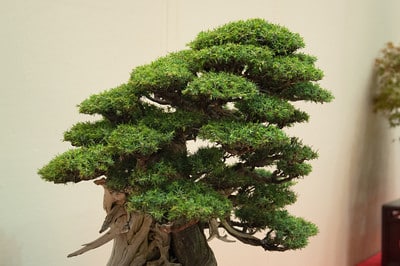
Needle juniper seen from the left side
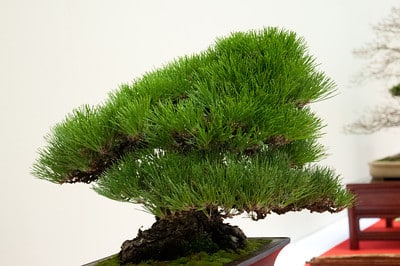
Black pine from the left side
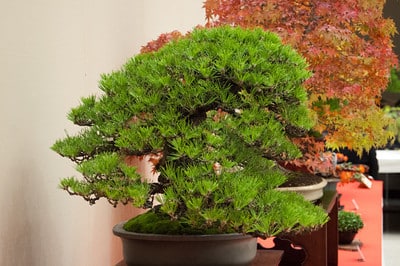
Another black pine from the left side
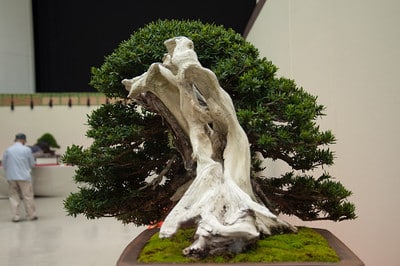
Yew – right side
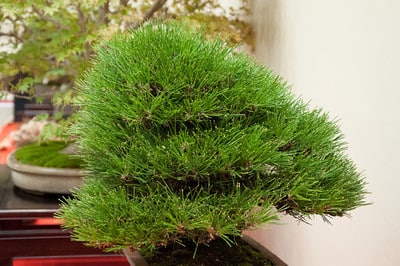
Black pine – right side
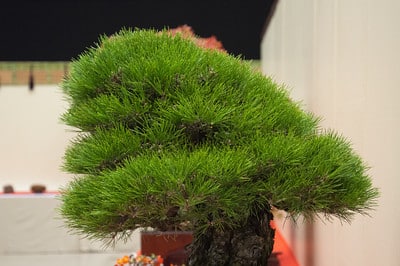
Black pine – right side
The above trees were shown at the 2011 Gomangoku, the Daiju-en family exhibit. Although the trees here represent work done by professionals trained in Central Japan, one can find varying states of lean in bonsai throughout Japan. (For another great example of the helmet look, see “A really full black pine.”)
I only thought to snap a single shot from above to capture just how far forward some of these trees lean.
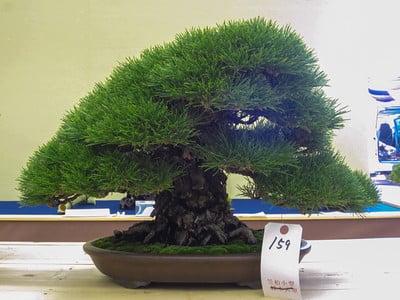
Black pine at the 2011 Taikan-ten (check out the tiny pot!)
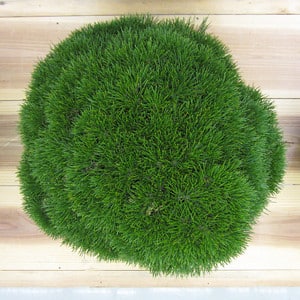
Same tree from above – the apex is at the bottom right (note the amazing density!)
I’ll try to take more shots from above going forward. In the meantime, feel free to let us know what you think about the lean.
Subscribe to Bonsai Tonight
New Posts Delivered Every Tuesday and Friday
Andy Rutledge (@andyrutledge) says
Hey Jonas,
Boon is, of course, correct. As bonsai is an artistic endeavor, our work is beholden to how people might be able to perceive at once beauty, interest, and some reference to their previous experience. Without that reference to a viewer’s contextual experience (re: what trees look like from the human perspective) our bonsai will not invite the proper or complete buy-in from viewers of our work.
The typical human perspective of grand trees is from the ground, often while standing under them and looking up in awe. Those trees do indeed lean over toward us (from our perspective). Bonsai must use artistic means to imply the same (forced) perspective – but that perspective also involves how close we (the viewers) are from the tree. Therefore a bonsai might have a powerful taper (sumo-esque) to indicate that we are standing very close, a medium taper to indicate a not-too-close perspective, or a slight taper to indicate a more distant view of the tree.
By the same token, a specific bonsai specimen may have or may be forced to have characteristics that require it to have a slight or more pronounced forward lean in order to properly convey the desired or appropriate forced perspective to viewers. Otherwise, the crown would need to disappear behind the lower branches (and that’s not a very appealing image).
As Boon’s student you know all of this, of course. But as you opted not to wax prolix here, I thought I might try and expound on the artistic reasons for it here for your readers. Hope this helps!
Kind regards,
Andy
Jonas Dupuich says
Well said, thanks Andy!
John Demaegd says
Maybe another reason for the front lean is to add depth without adding height?
Wilson Trindade says
The explanation of the slope from the apex to the front of the Japanese bonsai, is related to way to greet in Japan: a brief reference.
In the West, we squeeze hands when greeting. In Japan people not touching, if makes a reference. So the first impression of the viewer in relation to the bonsai is that they both shake hands – and bonsai should fazer uma beve reference to its viewer.
Trinity Wilson – Brazil
Satori Bonsai says
Love this! I have been wondering about this for a while now! Thank You for sharing
Juan says
Jonas, Muey buen. f viewed from an appropriate height the forward lean does give an element of scale that we miss with straight up and down trees. Just had this conversation at a gathering of bonsai practitioners here in the desert last evening, while completing a necropsy of the immediately prior exhibit.
Joe Gutierrez says
The Japanese tend to be anthropomorphic when it comes to bonsai, giving human attributes and characteristics to their trees. They feel that a tree should be like a dear friend, welcoming you with open arms. Thus – many of their trees have branches that, from the front, seem to be like welcoming arms … and the head nodding forward in greeting…!
don says
Great comment Joe! That is how it was explained to me when I first started wiring branches. Even formal up right trees have branches slightly going forward giving you the impression of welcoming arms.
Trung says
Dear Mr. Jonas,
I’m Trung, from Vietnam
Your black pine is very nice.
I want to buy seed of Mikawa, Kotobuki black pine.
Could you help me to buy it?
Thank you very much and best wish to you!
Jonas Dupuich says
Hi Trung – as far as I know, Kotobuki are grown from graft, not seed, and only a few folks sell the variety. Mikawa are more widely available, but I don’t know a good source online – maybe others have suggestions?